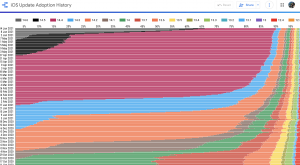The landscape of digital marketing has changed more in the past 6 months than it has in the past 6 years.
April 26th – iOS14.5 drops and completely flips the table on what the industry knew about paid advertising with App Tracking Transparency (ATT)
September 20th – iOS15 drops and further disrupts online marketing by introducing Mail Privacy Protection
To say we’ve had a few sleepless nights is an understatement. But without question, we pivot and we adapt.
Why has an iPhone update created so much disruption?
Whether it’s seeing which video ads on Instagram led to the most people to make a purchase on site, or how many people opened and clicked through on your latest email, being able to identify how your potential customers interact with your marketing material is crucial for getting the best ‘bang for your buck’.
And that’s exactly what the latest string of iOS updates have affected…
What has been the exact effect of iOS14 on media buying?
Reduced interest & behaviour audience sizes
Let’s take the ‘modern design’ as an example of an interest you’re able of targeting with your Facebook ads. 6 months ago the audience size you were capable of reaching was 60M.
Fast forward to today, that same ‘modern design’ audience is only capable of finding 30M. That’s because Facebook iOS users are opting out of app tracking, meaning Facebook is unable to identify as many people with this interest.
Reduced retargeting audiences
The story is the same here as given in the example above. Users that opt out of app tracking become anonymised, meaning if they land on your site, you can’t hit them with a 20% offer and get them back like you could previously. Because of this you might see your retargeting audience pools begin to shrink.
The amount of traffic your site receives likely hasn’t changed. But the amount of those site visitors you can target has.
Reduced and delayed tracking capabilities.
Anyone opted out of tracking is persona non grata in Facebook’s eyes.
They’re pretty much untrackable. Even if they see an ad, click and convert, Facebook will still have a tough time attributing that sale to that particular ad
Advertisers are now having to rely on different reporting methods such as Conversions API (cAPI) and Private Click Measurement (PCM), which can delay attribution up to 72 hours to match a conversion to Facebook.
But what about email marketing?
Apple’s new ‘Hide my email’ feature
This latest feature creates a random and unique email address for when you sign up to services/mailing lists that then forwards directly to your inbox.
This hides a user’s actual email, creating obvious problems for email marketers and brand owners alike.
Apple’s Mail Privacy Protection
This is a particularly large thorn in the side of email marketers. Any emails sent to users with this feature enabled will be displayed as ‘opened’, to the sender, even if the recipient ignores it.
This effectively removes ‘open rates’ as a reliable metric for success with no way of knowing if your numbers can be trusted.
How can brands navigate the new changes?
1. Stay Informed
Keeping on top of industry news will keep you informed and help you make sense of your own numbers and advertising performance changes.
The world of digital advertising is changing by the minute, and taking that into account when reviewing marketing performance is vital.
2. Keep calm… Not all users are impacted
iOS devices make up 47% of all smartphones. Only iOS devices are affected by these changes.
Apple Mail and Apple mobile devices make up 35%* only of the email provider market share globally. No other providers have announced such changes
3. Adjust your goal posts
With email, consider changing your success metric to click-through-rate rather than open-rate. This will provide a much more accurate way of examining performance!
Factor in underreporting. For both email marketers and media buyers alike, mass-underreporting is happening industry-wide.
On platform results are being skewed by our ability to track through them, which leads onto the next point…
4. Utilise UTM tracking
Tracking your performance through Google Analytics using UTM parameters is essential to getting the most unbiased view of your marketing.
While Google Analytics only operates on a last click attribution model, likely discounting delayed attribution of your ad performance, you can be certain your results will be a little more reliable!
The same goes for email marketing. Cover your email links and buttons head to toe in UTM tracking to make sure you can see what’s happening as clearly as possible.
5. Focus on high-level metrics
With on-platform metrics underreporting, metrics such as Media Efficiency Ratio (MER) and overall Cost Per Acquisition (CPA) are far firmer figures to examine.
Being able to calculate the efficiency of your total advertising costs vs revenue should always be the cornerstone metric of any brand
6. Be adaptable
Potentially the most important point you need to take away from this blog.
The ability to pivot and find success is a make or break situation for a brand. If Facebook isn’t working for your brand, moving advertising spend into TikTok, Google ads, Pinterest etc and finding your audience is more important now than ever.
One more thing…
Regardless of what methods you utilise to help your brand survive and thrive the tides of change, being able to embrace that change, and pivoting is what has allowed us to continue to scale and kill it with the brands we work with.
The methods, tricks and tactics we use might change, but the fundamentals remain the same. Having a killer product, great content and reaching the correct audience will do more for your brand than any ‘Facebook Ad Guru Hacks’ you might find on YouTube.
Sources
https://www.statista.com/statistics/236550/percentage-of-us-population-that-own-a-iphone-smartphone/
https://blog.hubspot.com/marketing/how-apples-ios-15-could-impact-email-marketers





